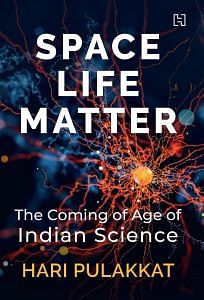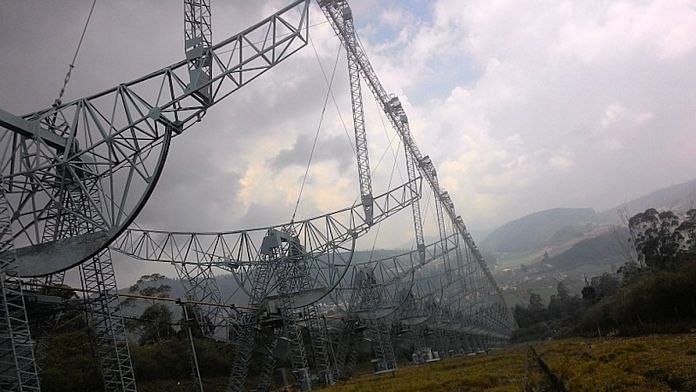The Ooty Radio Telescope is situated in a reserve forest in the Nilgiri mountains, close to the village of Muthorai. A glance from the vantage point of the observatory office reveals the extent of human activity around the campus. Overlooking the observatory is the swanky Good Shepherd International School, one of Ooty’s most famous landmarks. Scattered all over the mountain landscape are buildings of all kinds: research centres, private residences, parks, overcrowded villages. In the 1960s, when the telescope was constructed, it was near-virgin territory. Few buildings, little vehicular movement, no interference from electronics. Todas, the original inhabitants of the Nilgiri mountains, used to live around the forest. During his visits to Ooty, Bhabha didn’t tell the Todas about the real objectives of TIFR to avoid trouble. Yet there were more than a few murmurs from people. Newspapers wrote about the project coming up in a reserve forest. Questions were asked in Parliament. Bhabha prevailed in the end. He got 300 acres for the TIFR astronomy centre in Ooty.
The young astronomers loved the quietness of Ooty and the high vantage point, the forests with animals and birds, the lack of excessive electrical noise, the cool temperature. In the 1970s, when ambitions were low in India, young scientists did not mind living in an isolated place like Ooty, where there were limited possibilities for their spouses and children. It rained often in the mountains but astronomical observations were not affected. Cloud cover does not interfere with radio waves. Bright sunlight does not overpower radio waves either, the way it crowds out light from the stars. But they are sensitive to electrical interference, so sensitive that electronic devices being operated in the surrounding cities can affect the results of an observation in Ooty. Fortunately, the high Nilgirimountains shielded the telescope from Coimbatore and Mysore, the two large nearby cities.
Electronic components in pesticide sprayers used in Ooty interfered with the functioning of the telescope. So did cable TVoperations. To avoid interference, astronomers at the observatory developed a new motor for the sprayers. Cable operators were persuaded to transmit in different frequencies. Complete isolation isn’t possible in the modern world, and astronomers have developed ingenious techniques to weed out noise from mobile phones and electric devices, although they are dealing with signals that have less than a trillionth of the energy transmitted by mobile phones. A cell phone placed on the moon would be the brightest object in the universe at night for radio astronomers, outshining all the stars and the planets. Looking for radio signals from the stars is like sifting through an entire city of hay to find one needle. Modern radio telescopes are among the most precise instruments ever built.
Also read: Why global body of engineers picked Pune radio telescope for rare honour
Swarup had built the telescope to study galaxies in the early history of the universe and to prove the Big Bang model of origin. This problem had been occupying his mind for several years, as the Steady State model had strong adherents among the astronomical community. The proponent of the Steady State theory, Fred Hoyle, refused to believe that the universe burst into being 10 billion years ago in a blinding flash (this number has since been revised to 13.7 billion years). There was not much evidence for the Steady State model, which said that matter was continuously being created as the universe expanded. There was no clinching evidence for the Big Bang model either in 1963, when Swarup conceived the telescope. The evidence arrived in 1965. Two radio astronomers at Bell Labs, Arno Penzias and Robert Wilson, discovered the remnant of the Big Bang with a simple horn antenna. This remnant was a radiation that permeated the universe at a temperature of around 2.73 Kelvin (–270.42 degrees centigrade), cooling down from tens of billions of degrees soon after the Big Bang. It was one of the landmark discoveries of the twentieth century – Penzias and Wilson won a Nobel Prize for it in 1978.
A disappointed Swarup wanted to search for additional evidence for the Big Bang and look back in time at the universe in its early stages of evolution. Would the early universe appear through the telescope as it does now? Would the galaxies look as they do now? The Ooty telescope was perfect for such work. It was the largest steerable telescope in the world, and four times more sensitive than the Jodrell Bank telescope in England. It was located in the right place, and worked at the right, although narrow, frequency. It could observe a large number of distant objects in a day. Swarup had a talented group of students.
Swarup’s first student Vijay Kapahi had led the development of the feed system of the telescope, 1,056 sensors – called dipoles – that detect the radio waves and convert them into electric currents that are brought into computers for analysis. In1975, Kapahi published a research paper showing that galaxies were more closely packed in the first few billion years of the universe after the Big Bang, thereby proving that the universe had evolved since then and was not in a steady state. Kapahi went on to become Swarup’s successor as the director of the National Centre for Radio Astrophysics (NCRA) in Pune. He continued to make discoveries in astronomy till he died in 1999, at the age of 55.
Swarup had built the telescope primarily to see far into the depths of the universe and therefore back in time. A new telescope is generally built for solving one big problem, but it will have plenty of other uses after it is constructed. The Ooty telescope was used to study radio galaxies, supernovae and quasars. It was used to study low-frequency radio emissions from the centre of the Milky Way. The telescope turned out to be particularly good to study fast-rotating and super-dense stars called pulsars, objects that were discovered just before the telescope was ready. Pulsars lie far away from the earth, the nearest of them being 770 light years away. The galaxies and hydrogen clouds that Swarup studied were several billion light years away. When he conceived the telescope, he had not thought that it could be used to look at nearby objects. P.K. Manoharan, a young observer working at the Ooty telescope, changed that notion. He used it to study the sun.
Also read: Moons with masks, sky on Skype — Covid has changed life for Bengaluru astronomers’ club
On 1 September 1859, the earth was hit by an unusual storm now called the Carrington Event. The sun had let go of a part of its corona and a stream of high-speed particles stormed the earth with serious consequences to industrial infrastructure. British astronomer Richard Carrington recorded the event, in which atmospheric flares were visible in many parts of the northern hemisphere. Telegraphic communication was badly affected by the solar storm. The earth has been hit by several solar storms since then, all of much lower intensity than the Carrington Event. One solar storm struck the earth in 1989, bringing down a part of Canada’s electric grid for nine hours. In July 2012, the sun produced a storm of a magnitude similar to the Carrington Event. It shot through the earth’s orbit at 3,000 kilometres per second, but the earth had passed that spot a week earlier. Had it hit the earth, the consequences to industrial infrastructure would have been devastating, and electrical grids and communication networks may have taken two years or more to recover.
The US National Academy of Sciences estimated that the damage to global economy would have been $2 trillion. Since the sun is so important to the health of our planet, scientists spend a lot of time studying it. Observatories have gone up in space to study the sun. Telescopes on the earth keep a close watch on its behaviour. The sun is not just a plain fireball. It has a complicated structure. It evolves in time. It waxes and wanes. Its influence extends beyond the farthest planet of the solar system. To stretch a point, we live inside the sun.
 Excerpted with permission from ‘Space Life Matter’ by Hari Pulakkat, published by Hachette India
Excerpted with permission from ‘Space Life Matter’ by Hari Pulakkat, published by Hachette India



